Experts rank holiday activities that put Houston residents most at risk for COVID-19
COVID-19
The Texas Medical Association has released its COVID-19 holiday risk chart, a ranking of popular activities based on how likely one is to contract the novel coronavirus.
With infections spiking in Houston and across the country, the chart was updated from its original version with input from physicians on the TMA COVID-19 Task Force and the TMA Infectious Diseases Committee. Together, the group identified popular seasonal activities and the calculated the risk of spreading the virus.
"It's back! The TMA #COVID19 Task Force has developed a new version of our popular risk assessment chart to help you choose your activities wisely this holiday season," the Austin-based association said in a November 17 tweet accompanying the new chart.
Using a ranking of 1 to 10, the chart measures everything from viewing holiday lights with family in a car (1) to attending an outdoor public tree lighting ceremony (4) to celebrating New Year's Eve at a bar or club (10).
The chart also measures the thing we're perhaps most worried about during the holiday season: spending time with loved ones.
Based on the TMA risk chart (and pretty much all scientific experts), it's safer to only interact with your immediate household this year. Typical activities like decorating a gingerbread house with another household (4) or traveling by plane to visit family or friends (5) run a moderate risk, while taking photos with Santa (7), shopping in-person on Black Friday (8), and attending a large indoor celebration with singing (10) pose a moderate-to-high risk.
The Centers for Disease Control issued similar holiday guidelines on November 11, encouraging people to limit interactions with those outside their immediate household. If possible, host gatherings outside and keep all non-family members at least six feet apart.
Masks should be worn unless eating or drinking and especially when in airports, bus stations, train stations, gas stations, and rest stops.
------
This article originally ran on CultureMap.






